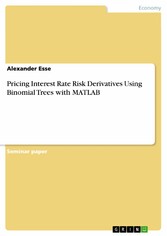Pricing Interest Rate Risk Derivatives Using Binomial Trees with MATLAB
von: Alexander Esse
GRIN Verlag , 2018
ISBN: 9783668726376
, 32 Seiten
Format: PDF
Kopierschutz: frei
Preis: 6,99 EUR
eBook anfordern 
Mehr zum Inhalt

Pricing Interest Rate Risk Derivatives Using Binomial Trees with MATLAB
Seminar paper from the year 2017 in the subject Business economics - Investment and Finance, grade: 1,00, University of Tubingen, language: English, abstract: In this assignment we approximate Oldrich Vasicek's (1977) term structure model with a binomial approach and show that it is convenient to use a recombining binomial tree to value interest rate derivatives in the Vasicek model. First, we illustrate that our applied binomial approximations converge to the dynamic continuous-time Vasicek model with an increasing number of time steps (subperiods). Furthermore, we apply the binomial approach to value a Discount Bond, Coupon Bond and a Futures Contract on both a Discount and Coupon Bond. The resulting approximations will be compared to the respective analytical solution, which we use as a benchmark. Thirdly, we determine the fair value of both an European and American Call and Put on a Discount Bond and Coupon Bond, respectively. We demonstrate that our estimated binomial prices converge with an increasing number of time steps. Moreover, we analyze both the behaviour of a Sraddle on a Discount Bond and the Early Exercise Premium of the considered American Options as a function of spot interest rates. We obtain all results shown in this report from the software 'Matlab'. Hence, the submitted 'm.files' should be taken as a reference for a better understanding of the calculation procedures described in this report (Relevant Code is depicted in the Appendices). Furthermore, to reduce computational effort and required time to run our code we apply a joint calculation of specific approximations rather than run a code individually for each Task. This is mainly because some specific securities and interest rate derivatives require the same underlying and identical matrices of the interest rates and transition probabilities from the binomial trees for the approximation procedure. This approach is suitable because we apply the identical number of subperiods for specific Tasks and, thus, for the respective securities and or derivatives.











